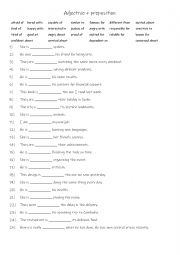
|
A2+-B1 25 Adjective + prepositions
Understanding how adjectives combine with prepositions helps students provide more detailed and precise descriptions. For example, knowing the phrase �interested in� allows you to convey specific interests more clearly.Mastering these combinations contributes to overall language proficiency, allowing you to use English more accurately and confident...
Level: intermediate
Age: 10-100
Type:
Downloads: 117
|
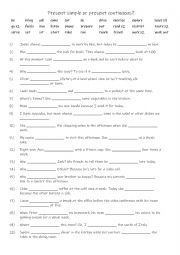
|
A2-B1 Present simple or present continuous?
Students read the sentences and complete the gap-fill using the verbs in bold with the correct tense.Answers on page 2.
Level: elementary
Age: 8-100
Type:
Downloads: 117
|
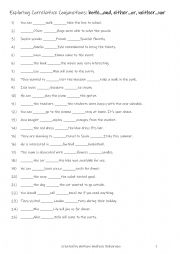
|
A2 -B1 Exploring Correlative Conjunctions both...and, either...or, neither...nor
These conjunctions help students clearly express relationships between ideas or items in a sentence. They provide a way to connect words, phrases, or clauses in a balanced and structured manner.Mastery of correlative conjunctions can enhance students overall writing and speaking skills. They add variety and sophistication to your language, making y...
Level: intermediate
Age: 10-100
Type:
Downloads: 117
|
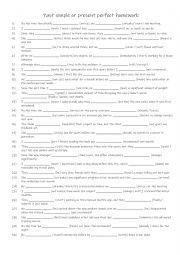
|
B1-B2 Past simple v present perfect
Understanding these tenses improves students� ability to interpret and respond to conversations and texts that involve past and present actions. It aids in following narratives and discussions more effectively.Mastery of these tenses allows learners to speak and write with greater accuracy and fluency. They can more precisely communicate differen...
Level: intermediate
Age: 10-100
Type:
Downloads: 117
|
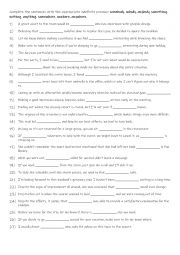
|
B1-B2 9 Indefinite pronouns
Each of the 9 indefinite pronouns is used 3 times. Students read the sentences and complete the gap-fill with the appropriate indefinite pronoun. Answers on page 2.
Level: intermediate
Age: 10-100
Type:
Downloads: 117
|
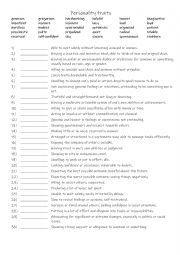
|
B1-B2 30 Personality traits
Students familiarise themselves with the 30 adjectives then read the definitions. They write the word next to the definition. After the worksheets have been checked, this worksheet could also be used for a speaking reinforcement activity. Students could say what they look for in a partner, or to describe themselves or someone they know.Answers on p...
Level: intermediate
Age: 10-100
Type:
Downloads: 117
|
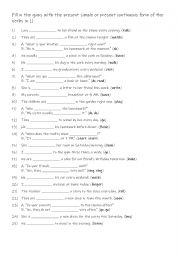
|
A1+ Present simple or continuous
Students read the sentences to work out which tense is required to complete the gap-fill using the given verb in bold i (). Answers on page 2.
Level: elementary
Age: 9-100
Type:
Downloads: 117
|
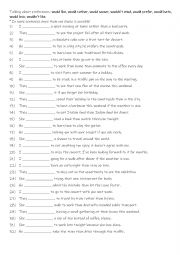
|
B1+-C1 Talking about preferences -would like, would rather, would sooner, would not mind, would prefer, would hate, would love & would not like.
Students familiarise themselves with the different ways of expressing their preferences and grammatical usage. Then they read each sentence to see which one is the most suitable to complete the gap-fill. Each form is used 4 times. Answers on page 2.
Level: intermediate
Age: 10-100
Type: worksheet
Downloads: 117
|
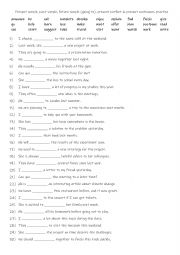
|
A2+-B1 Present simple, past simple, future simple (going to), present perfect & present continuous practise
Practising these essential tenses at A2+ to B1 levels helps learners communicate clearly about routines, past events, future plans, and ongoing actions. The present simple describes regular habits and truths, while the past simple is used to recount completed actions. Future simple (going to) helps with discussing future plans, present perfect conn...
Level: elementary
Age: 8-100
Type:
Downloads: 117
|
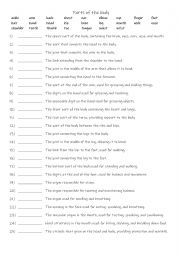
|
A1+-A2 25 parts of the body definitions
Learning these 25 body parts and their definitions is helpful for basic communication about health and daily activities. Knowing the names of body parts allows students to explain how they feel, describe symptoms to doctors, and understand instructions related to movement or health care. These words are also common in simple conversations and expre...
Level: elementary
Age: 8-100
Type:
Downloads: 117
|












